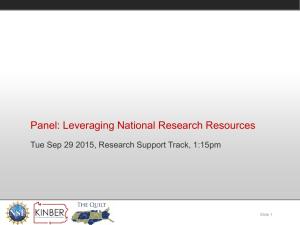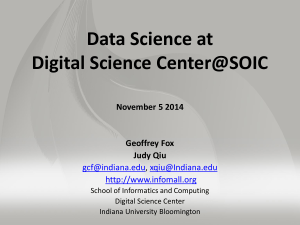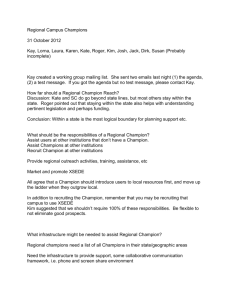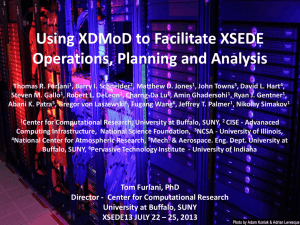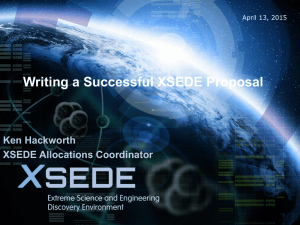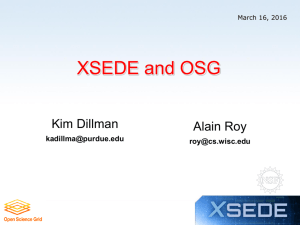Document 10496463
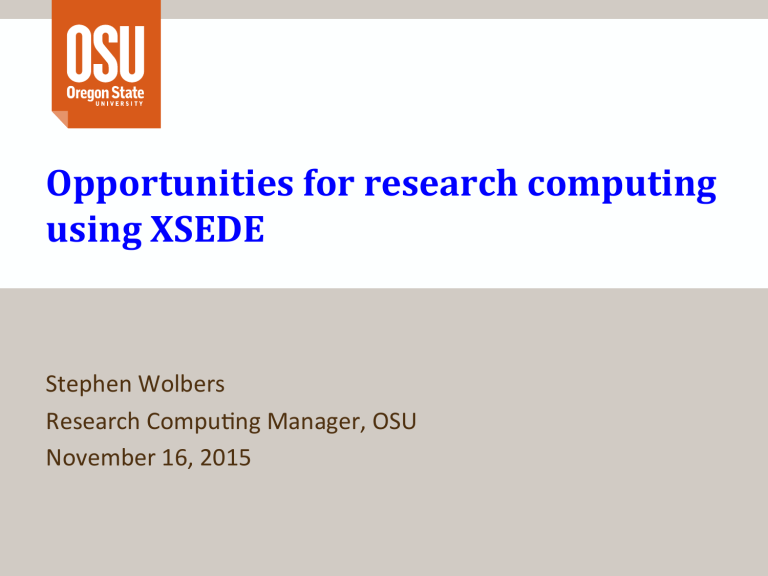
Opportunities for research computing using XSEDE
Stephen Wolbers
Research Compu4ng Manager, OSU
November 16, 2015
Outline
• Introduc4on to this series of research compu4ng events
• Introduc4on to NSF XSEDE compu4ng
• Who uses XSEDE?
• XSEDE Resources
• GeKng started with XSEDE
• GeKng Help
• XSEDE Future + other facili4es
• Summary
2
Stephen Wolbers XSEDE at OSU, Nov 16, 2015
Outline
• Introduc)on to this series of research compu)ng events
• Introduc4on to NSF XSEDE compu4ng
• XSEDE Resources
• GeKng started with XSEDE
• GeKng Help
• XSEDE Future + other facili4es
• Summary
3
Stephen Wolbers XSEDE at OSU, Nov 16, 2015
Introduction to this series
• Sponsors: Center for Genome Research and Biocompu4ng
(CGRB), College of Earth, Ocean, and Atmospheric Sciences
(CEOAS), College of Engineering COE), College of Science (COS),
Informa4on Services (IS) and the Office of Research
• We are beginning a series of events to share informa4on, discuss technology, build a community, and introduce people to others at Oregon State University that engage in research and research compu4ng.
• Similar idea to events at UC Berkeley. There are some nice topics there hZp://research-‐it.berkeley.edu/reading-‐group
• Not meant to supplant or duplicate other efforts.
4
• We plan to start with a few events and see how it goes and adjust.
Stephen Wolbers XSEDE at OSU, Nov 16, 2015
Some ideas for topics
5
• Any ideas for presenta4ons, training, topics, etc. will be most welcome. We’ll try to cover them.
• XSEDE (today)
• Visualiza4on
• Parallel compu4ng
• GPU, Intel Phi, Mul4-‐core, 4ghtly-‐couple architectures
• Amazon AWS, Microsod Azure, Google, Research clouds
• Storage
• Vendor presenta4ons
• Networking
• Data Management/Data Preserva4on
Stephen Wolbers XSEDE at OSU, Nov 16, 2015
Outline
• Introduc4on to this series of research compu4ng events
• Introduc)on to NSF XSEDE compu)ng
• Who Uses XSEDE?
• XSEDE Resources
• GeKng started with XSEDE
• GeKng Help
• XSEDE Future + other facili4es
• Summary
6
Stephen Wolbers XSEDE at OSU, Nov 16, 2015
7
Stephen Wolbers XSEDE at OSU, Nov 16, 2015
Introduction to XSEDE
• XSEDE is an NSF program, funded for 5 years, that provides research compu4ng for the US research community.
• XSEDE describes it as follows:
• “The Extreme Science and Engineering Discovery Environment (XSEDE) is the most advanced, powerful, and robust collec4on of integrated digital resources and services in the world. It is a single virtual compu4ng system that scien4sts can use to interac4vely share resources, data and exper4se.”
• Sounds preZy good!
8
Stephen Wolbers XSEDE at OSU, Nov 16, 2015
Is XSEDE right for you? (Or are you right for XSEDE?)
• If your computa4on can be done on a desktop/laptop or a small cluster then XSEDE is probably not for you.
• If your computa4on involves substan4al computa4on 4me and/or uses specialized hardware or sodware XSEDE is likely to be the right thing to consider.
• You do not need your research to be NSF funded (but it is taken into account when alloca4ons are granted)
9
• Some examples of XSEDE computa4ons include:
• Climate models
• Fluid dynamics
• Computa4onal chemistry
• Large memory applica4ons
• Intel Phi or GPU applica4ons
Stephen Wolbers XSEDE at OSU, Nov 16, 2015
Who uses XSEDE?
• Currently 1602 alloca4ons na4on-‐wide
• hZps://www.xsede.org/ac4ve-‐xsede-‐alloca4ons for details
• Here is a liZle extract from the alloca4on list:
• 1577. Yuyang Zhang, Oak Ridge Na)onal Laboratory
Materials Research van der Waals Interac4on: Its’ Applica4on in Oxide
1578. Zhe Zhang, Howard Hughes Medical Ins)tute
Molecular Biosciences Cryo-‐EM Structural Studies of ATP Binding
CasseZe Transporters Implicated in Human Health
1579. Zhuhua Zhang, Rice University
Materials Research Growth mechanism of two-‐dimensional (2D) materials
1580. Xinyu Zhao, University of Connec)cut
Engineering Large eddy simula4on/probability density func4on modeling
of two-‐phase reac4ve turbulent flows
10
Stephen Wolbers XSEDE at OSU, Nov 16, 2015
XSEDE use by ?ield (last week, from the XSEDE portal)
11
Stephen Wolbers XSEDE at OSU, Nov 16, 2015
Who uses XSEDE at OSU?
• April, 2015 : OSU had 6 grants and 2.4 million SU’s (hours)
Other representa4ve land-‐grant universi4es varied from 3 to
60 grants and 1.8 million to 79 million SU’s
• October, 2015 : OSU has 5 grants and 4.0 million SU’s
• A mix of startup, research, and educa4onal grants
• I have a grant as a campus champion
• Out of about 1 billion SU’s awarded per year (and 4 billion
SU’s requested).
• So 0.4% of total – OSU clearly could compete for more!
• The OSU grants are in fields such as astrophysics, computa4onal flows, coastal/estuary hydrodynamics, coastal ocean modeling.
12
Stephen Wolbers XSEDE at OSU, Nov 16, 2015
Outline
• Introduc4on to this series of research compu4ng events
• Introduc4on to NSF XSEDE compu4ng
• Who Uses XSEDE?
• XSEDE Resources
• GeKng started with XSEDE
• GeKng Help
• XSEDE Future + other facili4es
• Summary
13
Stephen Wolbers XSEDE at OSU, Nov 16, 2015
An old NSF view of computing, updated slightly
>10 PFlop
BLUE WATERS
1-10 PFlop XSEDE
Campus
14
Stephen Wolbers XSEDE at OSU, Nov 16, 2015
What XSEDE resources are available?
• XSEDE is not just supercomputers. It includes storage, visualiza4on and high throughput compu4ng.
• The next genera4on of resources, being put in place now, are moving toward providing computers, storage, and services that expand the scope of XSEDE beyond the classic 4ghtly coupled parallel applica4on. “HPC for the 99 Percent”
• HPC = High Performance Compu4ng
Stampede at
TACC
15
Stephen Wolbers XSEDE at OSU, Nov 16, 2015
XSEDE Resources https://www.xsede.org/resources/overview
• HPC Systems: ( Comet, Gordon, Stampede, SuperMIC and
Wrangler )
• Advanced VIS Systems: ( Maverick )
• HTC (High Throughput Compu4ng) Systems: ( Open Science
Grid (OSG) )
•
Storage Systems: (
Data Oasis, Ranch, XWFS ) * Ranch and
XWFS are the only storage resources that can be requested without compute resources.
• New resources coming early 2016
• PSC Bridges
• IU/TACC Jetstream
16
Stephen Wolbers XSEDE at OSU, Nov 16, 2015
XSEDE Hardware Systems Locations
Gordon
Comet
Stampede
Wrangler
Maverick
Jetstream
17
Stephen Wolbers XSEDE at OSU, Nov 16, 2015
Jetstream
Mason
Greenfield
Bridges
SuperMIC
XSEDE Gateways
• XSEDE has a concept of gateways to allow large numbers of researchers rela4vely seamless access to XSEDE resources.
• The work is done in the “middleware”
• The researcher uses a front-‐end to specify
the calcula4on/problem
Specify
Calculation
• The gateway handles the job assembly and
submission as well as the return of results
Gateway
• Large computa4onal power for a
large number of people
• One example: CIPRES, phylogene4cs codes
• 12,000 users
• Evolving to a CIPRES notebook environment, based on Jupyter
Assemble
Job and
Submit
18
Stephen Wolbers XSEDE at OSU, Nov 16, 2015
Gateways
• Gateways are listed at:
• hZps://www.xsede.org/gateways-‐lis4ng
• There were 30 listed as of early November, 2015
• Gateways are considered a good mechanism for extending the range of users well beyond the standard “power users” and the use of gateways is expected to increase as XSEDE moves into its next 5-‐year phase.
• There is a wealth of informa4on on the XSEDE web pages and in various symposiums, tutorials, etc.
• I took a tutorial at XSEDE15 and was performing Computa4onal
Chemistry calcula4ons within an hour or two, albeit without full understanding of the sodware I was using.
19
Stephen Wolbers XSEDE at OSU, Nov 16, 2015
XSEDE Resources
:
Extended Collaborative
Support(ECS) https://www.xsede.org/ecss
• Dedicated, but limited, XSEDE staff assistance
• 5 Ques4ons which are part of resource request sec4on of
applica4on
• Reviewers rate need for ECS
• Interes4ng possibility for large projects, especially across mul4ple ins4tu4ons
20
Stephen Wolbers XSEDE at OSU, Nov 16, 2015
Other resources of XSEDE
• Informa4on
• Mailing lists are extremely ac4ve and useful
• Topics have included filesystem technology, sodware stacks, batch systems, job openings, etc.
• Mee4ngs
• XSEDE yearly, regional, monthly mee4ngs
• Contacts
• All kinds of contacts, technical, subject maZer experts, other campus champions, managers, etc.
• Training
• Domain Champions
• Student campus champions
• Lots of job openings for computer professionals
21
Stephen Wolbers XSEDE at OSU, Nov 16, 2015
Outline
• Introduc4on to this series of research compu4ng events
• Introduc4on to NSF XSEDE compu4ng
• Who Uses XSEDE?
• XSEDE Resources
• Ge`ng started with XSEDE
• GeKng Help
• XSEDE Future + other facili4es
• Summary
22
Stephen Wolbers XSEDE at OSU, Nov 16, 2015
How to use XSEDE – getting started with XSEDE
• Start with the web pages (xsede.org)
• User Services -‐> GeKng Started Guide
• Talk to me (stephen.wolbers@oregonstate.edu)
• There are 4 main categories of access:
• Campus Champion alloca4on
• Startup alloca4on Development/tes,ng/
por,ng/benchmarking
• Research alloca4on Program
• Educa4on alloca4on Classroom/training
23
Stephen Wolbers XSEDE at OSU, Nov 16, 2015
Getting started with XSEDE
• One approach:
• Get a portal account
• Learn about resources
• Try a few out
• Apply for a startup grant (typically 1-‐2 pages)
• Run applica4ons, learn about a program’s behavior
• View “ Writing and Submitting a Successful XSEDE Proposal ”
• hZps://portal.xsede.org/successful-‐requests
24
• Apply for full alloca4on (4 proposal periods per year)
•
• Applica4on (something like 7-‐15 pages long + scaling documents and various lists of references and such)
Get alloca4on, run happily Page
Limit
Proposal Document
3
Progress report
10
New or Renewal
15 Over 10 Million SUs
Stephen Wolbers XSEDE at OSU, Nov 16, 2015
A few proposal suggestions from the XSEDE web pages
• Research must be clear and concise.
Someone outside of the field should be able to understand the proposal. Why is the chosen technique preferred over another? Are the proposal's objec4ves well defined?
• Outline all the proposed computa)onal algorithms and simula)ons
• Include any input parameters to be inves)gated and explain the choice of simula)on parameters.
• Describe any previous results and progress .
List all manuscripts (published, accepted, in prepara4on) made possible by using XSEDE resources. Clearly describe any progress to date. The XRAC (XSEDE Resource Alloca4on
CommiZee) tends to favorably review proposals that have a high "science-‐ to-‐SU" ra4o.
• Jus)fy the choice of resources .
Many research projects do not need access to high performance compu4ng resources. Make a strong case both for why you require supercompu4ng 4me in general and why you want to use a par4cular resource.
•
25
Jus)fy the amount of )me requested
Stephen Wolbers XSEDE at OSU, Nov 16, 2015
Resources that might justify the request for an allocation
• Intel MIC Co-‐Processors
• Large shared memory
• Large core counts for highly scalable applica4ons
• Specialized sodware installed on XSEDE systems
• High performance parallel file systems
• Low latency and/or high bandwidth interconnect
• Solid state (flash) scratch space
• GPGPUs
• Users reques4ng 4me on specialized systems such as
Stampede, Gordon or visualiza4on resources (Maverick) are expected to provide a stronger jus4fica4on. Projects that involve running large numbers of independent jobs should
26 consider using high throughput compu4ng resources .
Stephen Wolbers XSEDE at OSU, Nov 16, 2015
Outline
• Introduc4on to this series of research compu4ng events
• Introduc4on to NSF XSEDE compu4ng
• Who Uses XSEDE?
• XSEDE Resources
• GeKng started with XSEDE
• Ge`ng Help
• XSEDE Future + other facili4es
• Summary
27
Stephen Wolbers XSEDE at OSU, Nov 16, 2015
Getting Help -‐ Campus Champion
• I am OSU’s XSEDE Campus Champion
• I’m spreading the word and hopefully will assist people become aware of and use these facili4es.
• I have a campus champion alloca4on that can be used to help get people started.
• I can also help to get informa4on
• There is a lot of informa4on available coming through the campus champion mail list
• Other Help
• User News
• Knowledge Base
28
• User Forums
• XSEDE Help
Stephen Wolbers XSEDE at OSU, Nov 16, 2015
PSU
OSU
UO
UW
Campus Champion Institutions
Standard – 114
EPSCoR States – 69
Minority Serving Institutions – 12
EPSCoR States and Minority Serving Institutions – 10
Total Campus Champion Institutions – 205
Revised October 8, 2015
Domain Champions can provide specialist assistance
• Data Analysis Rob Kooper University of Illinois
• Finance Mao Ye University of Illinois
• Molecular Dynamics Tom Cheatham University of Utah
• Genomics Brian Couger Oklahoma State University
• Digital Humani4es Virginia Kuhn University of Southern
California
• Digital Humani4es Michael Simeone Arizona State University
• Chemistry and Material Science Sudhakar Pamidighantam
Indiana University
30
Stephen Wolbers XSEDE at OSU, Nov 16, 2015
Outline
• Introduc4on to this series of research compu4ng events
• Introduc4on to NSF XSEDE compu4ng
• Who Uses XSEDE?
• XSEDE Resources
• GeKng started with XSEDE
• GeKng Help
• XSEDE Future + other facili)es
• Summary
31
Stephen Wolbers XSEDE at OSU, Nov 16, 2015
New XSEDE resource -‐ Bridges
• Bridges is a new XSEDE system located at the PiZsburgh
Supercompu4ng Center.
• It is meant to provide a more flexible, user-‐focused, data-‐ centric environment.
• Empower new research communi4es (not just physics, chemistry, engineering)
• Bring desktop convenience to HPC
• Connect to campuses
• Drive complex workflows
• 3 types of compute nodes
• 4 ESM (12 TB memory)
32
• 10’s of LSM (3 TB memory)
• 100’s of RSM (128 GB memory)
• 48 RSM nodes with GPU’s
Stephen Wolbers XSEDE at OSU, Nov 16, 2015
Bridges – hardware architecture
33
Stephen Wolbers XSEDE at OSU, Nov 16, 2015
Bridges features
• Interac4vity for some applica4ons and users
• R, MATLAB
• Gateways are supported
• Galaxy, GenePaZern, MEGA
• Workflow systems such as Swid and Kepler to support new gateways
• Database nodes
• MySQL, PostgreSQL, MongoDB, CouchDB, Cassandra, Neo4j, eXistdb
• High-‐Produc4vity Programming Languages
• E.g. Python, MATLAB, R, Java
• Hadoop
• Provisioned on the RSM nodes, HDFS
• Virtualiza4on
• To provide customiza4on and containment
34
Stephen Wolbers XSEDE at OSU, Nov 16, 2015
Bridges features
• Compilers, debuggers and performance tools
• C++, C, Java, Fortran, etc.
• Intel, PGI, NVIDIA, Oracle, Con4nuum Analy4cs, GNU
• TotalView, PGI’s Graphical OpenMP/MPI parallel debugger
• TAU, PAPI, NVIDIA Visual Profiler, Intel Vtune Amplifier
• Applica4ons and Libraries
• Usual packages for physical sciences
• Parallel Boost Graph Library, Open CV, Theano, SuiteSparse
• GPU programming
• OpenACC, Support for Unified Memory for CUDA
• Scheduling
• OpenStack framework.
• SIMON scheduling module in PBS Torque
35
• OpenStack dashboard, Hadoop through Yarn
Stephen Wolbers XSEDE at OSU, Nov 16, 2015
Bridges Schedule
• Installa4on October, 2015
• Tes4ng November-‐December, 2015
• Produc4on in January 2016
• Ini4ally it will have all of the RSM nodes and a por4on of LSM and ESM nodes.
• Upgrades in October 2016
36
Stephen Wolbers XSEDE at OSU, Nov 16, 2015
New XSEDE resource -‐ Jetstream
Stewart, C.A. 2015. Jetstream: A national science and engineering cloud.
Presentation. Presented at the University of
Vermont, 30 September 2015, Burlington,
VT. http://hdl.handle.net/2022/20439
37
Stephen Wolbers XSEDE at OSU, Nov 16, 2015
Jetstream – Science domains and users
• Biology
• Earth Science/Polar Science
• Field Station Research
• Geographical Information Systems
• Network Science
• Observational Astronomy
• Social Sciences
• Jetstream will be particularly focused on researchers working in the “long tail” of science with born-digital data.
• One Jetstream focus will be enabling analysis of field-collected empirical data on the impact and effects of global climate change.
• Whatever you do … . unless what you do is large-scale parallel computing
• Stewart, C.A. 2015. Jetstream: A na4onal science and engineering cloud. Presenta4on. Presented at the University of
Vermont, 30 September 2015, Burlington, VT. hZp://hdl.handle.net/2022/20439
38
Stephen Wolbers XSEDE at OSU, Nov 16, 2015
Jetstream
• Test system acceptance report in DGA review
• Produc4on hardware arrived/arriving
• Research alloca4on requests due NEXT
THURSDAY Oct 22. Startup and educa4onal requests soon
• Unit of alloca4on is vCPU hour
• Early (very friendly) user 4me star4ng around SC15 (November 16, 2015)
• Early Opera4ons 22 Jan 2016
• Email to jethelp@iu.edu
for help with proposals, friendly user access, etc.
39
• Stewart, C.A. 2015. Jetstream: A na4onal science and engineering cloud.
Presenta4on. Presented at the University of Vermont, 30 September
The Future of XSEDE
• XSEDE is a 5-‐year program, funded through 2016.
• It was a follow-‐on from the Teragrid program, which ended in
2011.
• A follow on to XSEDE has been proposed and is in the process of being evaluated by the NSF.
• It has the clever name of XSEDE2, for the moment
• The strategy for XSEDE2 is to move beyond large supercomputer hardware and into more flexible and configurable systems.
• Supercomputers will remain, both in XSEDE and in Blue Waters
• Cloud compu4ng, large memory, more services and support
• Idea is to serve a much broader community
40
Stephen Wolbers XSEDE at OSU, Nov 16, 2015
Other national computational resources
• Blue Waters
• Supercomputer at NCSA, U of Illinois, aimed at Petascale computa4ons
• Proposals once per year in the fall
• NSF 14-‐518: hZp://www.nsf.gov/funding/pgm_summ.jsp?pims_id=503224
• EMSL Cascade
• Supercomputer at PNNL in Richland, WA
• Environmental Molecular Sciences Laboratory
• Proposals once year mid-‐December to January
• Must be related to the mission of EMSL
• hZps://www.emsl.pnl.gov/emslweb/proposal-‐opportuni4es
41
Stephen Wolbers XSEDE at OSU, Nov 16, 2015
Other national resources
• NCAR Yellowstone
• Supercomputer in Cheyenne, Wyoming
• Atmospheric, oceanic, and related sciences .
• Proposals hZps://www2.cisl.ucar.edu/docs/alloca4ons
• NASA Pleiades
• Supercomputer at NASA Ames Lab, Mountainview, CA
• NASA related science, must be a NASA sponsored researcher
• Proposals hZp://www.nas.nasa.gov/hecc/accounts/alloca4ons.html
• Open Science Grid (OSG) – Poten)ally quite interes)ng
• For loosely-‐coupled computa4ons (or high throughput computa4ons)
• Can be accessed through XSEDE or standalone
• Chameleon Cloud -‐ NSF
• New system, hardware at TACC and U of Chicago
42 • hZps://www.chameleoncloud.org/docs/geKng-‐started/
Stephen Wolbers XSEDE at OSU, Nov 16, 2015
Summary
• XSEDE is a compu4ng resource that is available to OSU researchers.
• XSEDE has computers, sodware, storage, networking, assistance and many other features.
• XSEDE is not for everyone – many compu4ng tasks can be done perfectly well on local facili4es.
• Other na4onal resources should also be considered.
• Please come talk to me if you are interested in learning more.
• stephen.wolbers@oregonstate.edu
43
Stephen Wolbers XSEDE at OSU, Nov 16, 2015
EXTRAS
Bridges – Database, Web and Data Transfer Nodes
• Database nodes
• 128 GB, op4mized for high performance for rela4onal and NoSQL databases.
• Some with SSD’s
• Some with large hard disk arrays
• Web Server nodes
• 128 GB, op4mized for internet applica4ons and gateways to community datasets.
• Data Transfer nodes
• 128 GB, 10 GigE, high performance data transfers to XSEDE, instruments, other advanced cyberinfrastructure and campuses
45
Stephen Wolbers XSEDE at OSU, Nov 16, 2015

